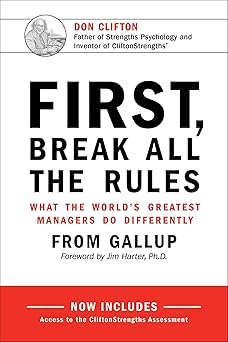
It's amazing how different people can be and still be successful, isn's it? I remember once, a young woman in my community started a small bakery. Everyone told her to follow a certain recipe, a certain way of doing things. But she just couldn’t. She tried, she really did, but it just didn't feel right. She ended up creating her own style, her own way of baking, and it turned out wonderfully. People loved her unique treats, and her business thrived. This book shares a similar idea – that the best leaders aren’t always the ones who follow the standard playbook. It's about understanding that great managers don't look the same. They come from different backgrounds and have varied styles. What truly sets them apart isn’t a cookie-cutter approach, but a willingness to challenge what’s expected. It's a look at what makes some managers truly exceptional, and the findings are surprisingly different from what many believe makes a good leader. It’s a chance to rethink how we approach management and recognize that sometimes, breaking the rules can lead to incredible results.
The book presents the results of a large study involving over 80,000 managers. It's not about trying to force everyone to be perfect or trying to fix what they struggle with. Instead, it focuses on finding out what people are naturally good at and helping them use those talents. The study looked at managers in all sorts of places, from big companies to small businesses, and the key takeaway is this: the best managers focus on strengths, not weaknesses. They select people based on their natural abilities, set clear goals, and create an environment where people can shine. It's a refreshing perspective because it acknowledges that everyone has different talents, and the best way to get the most out of people is to build on what they already do well. What’s really powerful is the understanding that front-line managers—the people directly overseeing employees—are the most important factor in keeping good people and getting the most out of them. The findings aren't just about ideas; they provide a practical measuring stick—12 statements—that can be used to see how a department is performing and how it compares to others. It shows a real connection between how employees feel and how well a company does, impacting things like profits, customer satisfaction, and employee turnover.
Ultimately, this is a guide for anyone in a leadership role, no matter how big or small their team. It isn't a complicated read; it’s meant to be something you can apply directly to your own work. The beauty of it is that it shows you how to identify and nurture talent, rather than trying to force people into a mold. It offers a new way of thinking about management, one that celebrates individuality and focuses on what people do best. It's a reminder that leadership isn’t about following a prescribed path but about understanding people, recognizing their unique strengths, and creating an environment where they can thrive. And along with the book, you can even take an assessment to better understand your own strengths and those of your team, which can be a really valuable tool for growth and improvement.
It's truly remarkable how much we try to fit people into boxes, isn’t it? I’m reminded of a young man I knew who wanted to be a musician. His parents, wanting what they thought was best, pushed him toward a “stable” career. He tried, he really did, but the joy just wasn't there. He felt like he was living a life that wasn't truly his, constantly striving to meet expectations that weren’t aligned with his spirit. It made me think about how many people feel that way in their jobs, feeling pressured to conform to a certain way of leading, a specific management style. This book explores that very idea, questioning the common belief that there’s a single, right way to be a good manager. It challenges us to reconsider what we value in leadership, suggesting that the most effective leaders aren’t necessarily those who perfectly embody a traditional mold. It's about understanding that people leading teams come from diverse backgrounds, have unique experiences, and naturally approach management differently. It's a refreshing perspective on what makes a manager truly stand out – not by following a set of rules, but by embracing individuality and understanding that different approaches can lead to wonderful outcomes. It really made me think about the importance of letting people be themselves and finding ways to build on what they're naturally good at.
The research behind this exploration is fascinating. Imagine looking at the way over 80,000 managers operate! It's not about identifying flaws or trying to "fix" people. Instead, it's a journey to discover what talents people possess naturally and how to best utilize those abilities. The study examined managers across a wide range of settings, from large corporations to small, local businesses, and the core message resonated deeply: successful managers prioritize strengths, rather than dwelling on weaknesses. They carefully select individuals based on their inherent talents, establish clear and achievable goals, and foster a work environment where everyone can truly shine. What makes this approach so powerful is the recognition that everyone possesses different skills and the best results come from nurturing those existing capabilities. It also highlights the crucial role of those front-line managers – the ones directly supervising employees – as the key to retaining talent and maximizing productivity. There's even a practical tool provided, a set of statements, that can be used to gauge performance and compare departments, showing a clear link between employee well-being and overall company success, affecting things like customer satisfaction and how often people leave their jobs.
This is more than just a read; it's a guide for anyone who finds themselves leading a team, no matter how small. It's written in a way that makes it easy to understand and apply to your own work immediately. The real beauty of the book lies in its focus on recognizing and nurturing talent rather than forcing people into predetermined roles. It offers a new way of thinking about leadership, one that celebrates differences and concentrates on what people do best. It’s a constant reminder that true leadership isn't about following a prescribed path, but about understanding the people you work with, appreciating their unique qualities, and creating a place where they can all flourish. And, as an added bonus, you can even take a self-assessment to get a better sense of your own strengths and those of your team, offering a wonderful opportunity for personal and professional growth.
Rating: 5.0 / 5.0
It’s easy to feel like we need to follow a specific way of doing things, isn’s it? I recall a teacher who always insisted on a particular method of solving problems. Some students thrived, but others felt lost and discouraged. This book shares a similar idea, gently questioning the common belief that there's one right way to lead. It's about recognizing that effective managers are diverse, coming from different places and using unique approaches. The book shares surprising findings based on a large study of managers, and it focuses on what people are naturally good at. It’s not about making people perfect, but about helping them use their talents. What’s really powerful is the understanding that managers who focus on strengths—selecting people based on abilities, setting clear goals, and creating supportive environments—are the ones who truly make a difference. The insights are practical and easy to understand, and there's even a tool to help you see how your own department is performing. It's a guide for anyone leading a team, big or small, encouraging us to celebrate individuality and help people shine.








